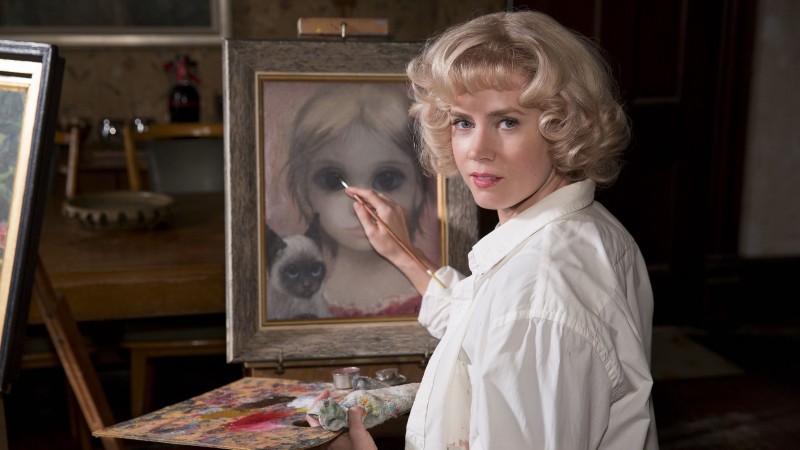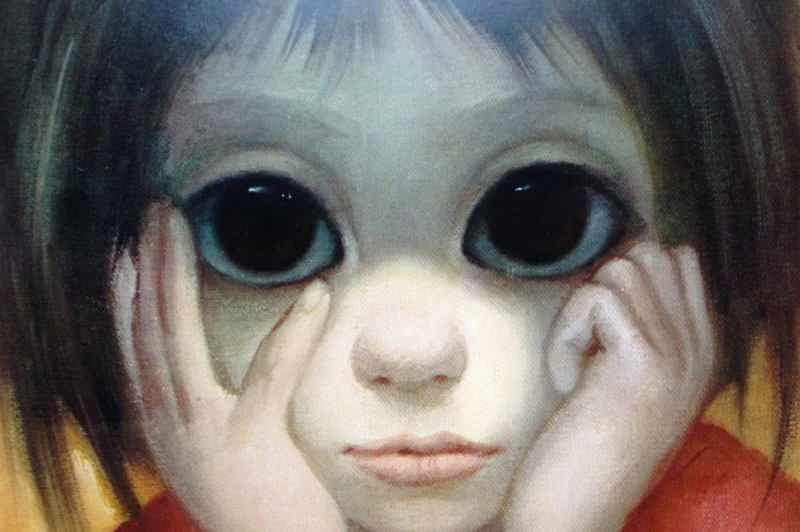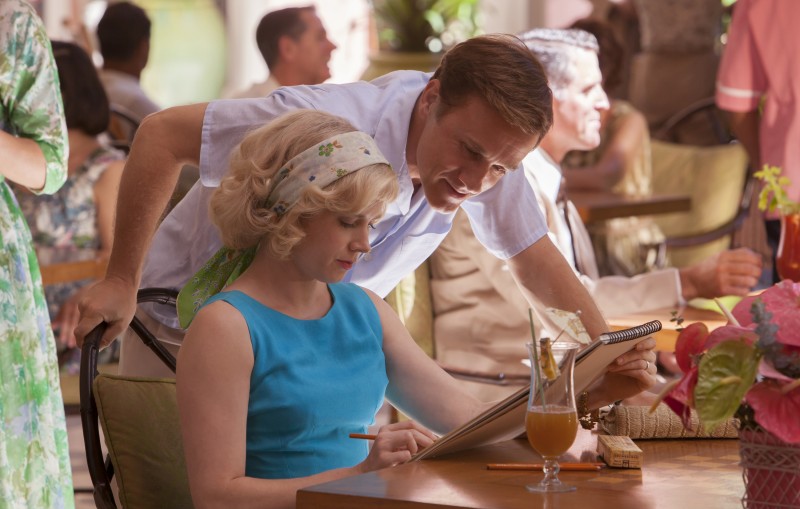Big Eyes Review
"An interesting story that crumbles under its drawn-out cinematic format and becomes clouded by extraneous detail "
After helming two films in 2012 (
Frankenweenie and
Dark Shadows), Tim Burton is back with perhaps his most odd project ever,
Big Eyes. Odd not because it contains a heightened Burtonesque surrealism and Johnny Depp in 25 roles, but because it is the complete opposite –
Big Eyes is the anti-Burton. Based firmly, to its detriment, in reality, Burton's film explores the “art” caper that consumed the kitsch paintings of Margaret and Walter Keane in the 1950's and 60's. Shying away from his proclivity towards overblown characters in a Robert Wiene-inspired world of hard lines and fantasy, and sticks his caper in the powder blue, pastel 50's; no room here for surrealism or imagination, lest one be blacklisted as a communist.

Margaret Ulbrich (Amy Adams) has had enough of her suffocating husband (so says our faithful narrator), so she packs up the car and leaves him; her daughter Jane (Delaney Raye as young Jane, Madeleine Arthur as older Jane) in tow. An outrageous act of defiant courage in mid-century America, Margaret shows her strength of will to forge her own path, and try to achieve her dreams in sunny North Beach, San Francisco. This, however, is the last act of bravery Margaret will show until the very end of the film. Shortly after her move, Margaret meets Walter Keane (Christoph Waltz); a local artist of moderate talent and “fame” in the Bay Area. Margaret's determined pride, apparently eaten up by her running away from domesticity, falters the moment she encounters hardship (in the form of her ex filing for custody), and she falls back into the “relative safety” of marriage. Margaret seems delighted to sign her artwork with her newly-acquired last name, and Walter begins to take full advantage. An adamant hustler, Walter has the gift of gab and during a moment of weakness, takes credit for his wife's work. This continues for over a decade, before Margaret finds the bravery she had at the onset of the film, and leaves.
Known for his wildly imaginative films, Burton's move to this biopic seems forced. The audience only gets a glimpse of the Burton to which we are accustomed (shown in the
trailer), two or three times in the form of real life big-eyes. He never dives into Margaret's creative process, nor her, likely beautiful, outlook on the world. Burton adds no flourish to his story, and it plays as if being read from a short “bio” section in Wikipedia. Conversations are drawn out more than they might be in such a format, but Burton otherwise covers the story in exceedingly broad stokes. Characters are overly-vapid and bland, offering very little other than a means to drive the narrative forward. Even powerhouse duo Amy Adams and Christoph Waltz are shoehorned into two-dimensional characters locked in a dull battle of domestic angst and overly-dramatized “art fraud.”

It is his portrayal of Walter and Margaret Keane that Burton truly falters. Perhaps he was unable to uncover large chunks of the story in his research, or Margaret was unwilling to further defame her ex-husband, or go into detail about her work, but the Keane's motivations for their actions are bizarre and widely-varying. Walter begins his fraudulence as a mistake, and as a way to complete a sale. This turns to a sociopathic mania by the end of the film, wherein Walter has become a drunken madman determined to do... something (Burton paints it as having his cake and eating it too). Diverting everywhere from severe megalomania to a love of art, Walter, and Waltz never quite understand why they want to steal Margaret's work.
Margaret's story is every bit as muddled as Walter's, in that, we never get to know her character, other than; one, she finds strength in religion, and two, she loves her art. Burton wants to portray Margaret as a powerful, strong-willed modern woman, but it seems like there was not enough supporting evidence to that claim, so he is forced to change the story. Perhaps having been surrounded by three generations of strong women during my formative years has spoiled me, but Margaret's actions are nearly impossible for me to justify or empathize with. If we accept the conceit that Margaret leaves her husband due to her internal defiant bravery (nearly unheard of in 1950's Midwestern America), then why does she fall back into the arms of a man so easily, and then let that man control her life for ten years? Perhaps Margaret Keane is just an average person; a consideration that would have grounded her character, making her more accessible than the pop-art martyr that inhabits
Big Eyes.

Tim Burtons does an admirable job with the composition of his shots and is aided immensely by cinematographer Bruno Delbonnel. Burton captures the freneticism of the San Francisco art scene in a bold, bright way inspired by the likes of Andy Warhol and Jackson Pollock. Burton is constantly playing around with his focal length to convey mood, using shallow to create isolation of Margaret, or deep to depict the growing distance between her and Walter.
Big Eyes' world is a bright and well-lit one, except for every shot that takes place in Walter's (Margaret's) studio. From the moment Margaret marries Walter, she switches from painting in the sunny outdoors, to various cramped and dark studio spaces, cut off from her daughter and the people buying massive quantities of her watered-down art. What once was a place of joy and expression, has become a dungeon of soul-less toiling.
What Burton has created with
Big Eyes is much like the art depicted within, kitsch. As Margaret notes several times within the film, “people want art that touches them,” and this piece simply did not strike a cord with me. Much of the conflict felt forced and out of place, and characters were impossible to identify with. It is fun to look at for a minute, but in the end, the Keanes' story seems better left to short newspaper articles, and Wikipedia pages.
Pros
- Great cinematography
- For what they're given, Waltz and Adams are positively charming (although odd, given Waltz's turn as the villain)
Cons
- Too narrowly focused on the bizarre relationship between Walter and Margaret
- No character depth
- The film seems to have a strong agenda, but cannot figure out what that agenda is
 Margaret Ulbrich (Amy Adams) has had enough of her suffocating husband (so says our faithful narrator), so she packs up the car and leaves him; her daughter Jane (Delaney Raye as young Jane, Madeleine Arthur as older Jane) in tow. An outrageous act of defiant courage in mid-century America, Margaret shows her strength of will to forge her own path, and try to achieve her dreams in sunny North Beach, San Francisco. This, however, is the last act of bravery Margaret will show until the very end of the film. Shortly after her move, Margaret meets Walter Keane (Christoph Waltz); a local artist of moderate talent and “fame” in the Bay Area. Margaret's determined pride, apparently eaten up by her running away from domesticity, falters the moment she encounters hardship (in the form of her ex filing for custody), and she falls back into the “relative safety” of marriage. Margaret seems delighted to sign her artwork with her newly-acquired last name, and Walter begins to take full advantage. An adamant hustler, Walter has the gift of gab and during a moment of weakness, takes credit for his wife's work. This continues for over a decade, before Margaret finds the bravery she had at the onset of the film, and leaves.
Known for his wildly imaginative films, Burton's move to this biopic seems forced. The audience only gets a glimpse of the Burton to which we are accustomed (shown in the trailer), two or three times in the form of real life big-eyes. He never dives into Margaret's creative process, nor her, likely beautiful, outlook on the world. Burton adds no flourish to his story, and it plays as if being read from a short “bio” section in Wikipedia. Conversations are drawn out more than they might be in such a format, but Burton otherwise covers the story in exceedingly broad stokes. Characters are overly-vapid and bland, offering very little other than a means to drive the narrative forward. Even powerhouse duo Amy Adams and Christoph Waltz are shoehorned into two-dimensional characters locked in a dull battle of domestic angst and overly-dramatized “art fraud.”
Margaret Ulbrich (Amy Adams) has had enough of her suffocating husband (so says our faithful narrator), so she packs up the car and leaves him; her daughter Jane (Delaney Raye as young Jane, Madeleine Arthur as older Jane) in tow. An outrageous act of defiant courage in mid-century America, Margaret shows her strength of will to forge her own path, and try to achieve her dreams in sunny North Beach, San Francisco. This, however, is the last act of bravery Margaret will show until the very end of the film. Shortly after her move, Margaret meets Walter Keane (Christoph Waltz); a local artist of moderate talent and “fame” in the Bay Area. Margaret's determined pride, apparently eaten up by her running away from domesticity, falters the moment she encounters hardship (in the form of her ex filing for custody), and she falls back into the “relative safety” of marriage. Margaret seems delighted to sign her artwork with her newly-acquired last name, and Walter begins to take full advantage. An adamant hustler, Walter has the gift of gab and during a moment of weakness, takes credit for his wife's work. This continues for over a decade, before Margaret finds the bravery she had at the onset of the film, and leaves.
Known for his wildly imaginative films, Burton's move to this biopic seems forced. The audience only gets a glimpse of the Burton to which we are accustomed (shown in the trailer), two or three times in the form of real life big-eyes. He never dives into Margaret's creative process, nor her, likely beautiful, outlook on the world. Burton adds no flourish to his story, and it plays as if being read from a short “bio” section in Wikipedia. Conversations are drawn out more than they might be in such a format, but Burton otherwise covers the story in exceedingly broad stokes. Characters are overly-vapid and bland, offering very little other than a means to drive the narrative forward. Even powerhouse duo Amy Adams and Christoph Waltz are shoehorned into two-dimensional characters locked in a dull battle of domestic angst and overly-dramatized “art fraud.”
 It is his portrayal of Walter and Margaret Keane that Burton truly falters. Perhaps he was unable to uncover large chunks of the story in his research, or Margaret was unwilling to further defame her ex-husband, or go into detail about her work, but the Keane's motivations for their actions are bizarre and widely-varying. Walter begins his fraudulence as a mistake, and as a way to complete a sale. This turns to a sociopathic mania by the end of the film, wherein Walter has become a drunken madman determined to do... something (Burton paints it as having his cake and eating it too). Diverting everywhere from severe megalomania to a love of art, Walter, and Waltz never quite understand why they want to steal Margaret's work.
Margaret's story is every bit as muddled as Walter's, in that, we never get to know her character, other than; one, she finds strength in religion, and two, she loves her art. Burton wants to portray Margaret as a powerful, strong-willed modern woman, but it seems like there was not enough supporting evidence to that claim, so he is forced to change the story. Perhaps having been surrounded by three generations of strong women during my formative years has spoiled me, but Margaret's actions are nearly impossible for me to justify or empathize with. If we accept the conceit that Margaret leaves her husband due to her internal defiant bravery (nearly unheard of in 1950's Midwestern America), then why does she fall back into the arms of a man so easily, and then let that man control her life for ten years? Perhaps Margaret Keane is just an average person; a consideration that would have grounded her character, making her more accessible than the pop-art martyr that inhabits Big Eyes.
It is his portrayal of Walter and Margaret Keane that Burton truly falters. Perhaps he was unable to uncover large chunks of the story in his research, or Margaret was unwilling to further defame her ex-husband, or go into detail about her work, but the Keane's motivations for their actions are bizarre and widely-varying. Walter begins his fraudulence as a mistake, and as a way to complete a sale. This turns to a sociopathic mania by the end of the film, wherein Walter has become a drunken madman determined to do... something (Burton paints it as having his cake and eating it too). Diverting everywhere from severe megalomania to a love of art, Walter, and Waltz never quite understand why they want to steal Margaret's work.
Margaret's story is every bit as muddled as Walter's, in that, we never get to know her character, other than; one, she finds strength in religion, and two, she loves her art. Burton wants to portray Margaret as a powerful, strong-willed modern woman, but it seems like there was not enough supporting evidence to that claim, so he is forced to change the story. Perhaps having been surrounded by three generations of strong women during my formative years has spoiled me, but Margaret's actions are nearly impossible for me to justify or empathize with. If we accept the conceit that Margaret leaves her husband due to her internal defiant bravery (nearly unheard of in 1950's Midwestern America), then why does she fall back into the arms of a man so easily, and then let that man control her life for ten years? Perhaps Margaret Keane is just an average person; a consideration that would have grounded her character, making her more accessible than the pop-art martyr that inhabits Big Eyes.
 Tim Burtons does an admirable job with the composition of his shots and is aided immensely by cinematographer Bruno Delbonnel. Burton captures the freneticism of the San Francisco art scene in a bold, bright way inspired by the likes of Andy Warhol and Jackson Pollock. Burton is constantly playing around with his focal length to convey mood, using shallow to create isolation of Margaret, or deep to depict the growing distance between her and Walter. Big Eyes' world is a bright and well-lit one, except for every shot that takes place in Walter's (Margaret's) studio. From the moment Margaret marries Walter, she switches from painting in the sunny outdoors, to various cramped and dark studio spaces, cut off from her daughter and the people buying massive quantities of her watered-down art. What once was a place of joy and expression, has become a dungeon of soul-less toiling.
What Burton has created with Big Eyes is much like the art depicted within, kitsch. As Margaret notes several times within the film, “people want art that touches them,” and this piece simply did not strike a cord with me. Much of the conflict felt forced and out of place, and characters were impossible to identify with. It is fun to look at for a minute, but in the end, the Keanes' story seems better left to short newspaper articles, and Wikipedia pages.
Tim Burtons does an admirable job with the composition of his shots and is aided immensely by cinematographer Bruno Delbonnel. Burton captures the freneticism of the San Francisco art scene in a bold, bright way inspired by the likes of Andy Warhol and Jackson Pollock. Burton is constantly playing around with his focal length to convey mood, using shallow to create isolation of Margaret, or deep to depict the growing distance between her and Walter. Big Eyes' world is a bright and well-lit one, except for every shot that takes place in Walter's (Margaret's) studio. From the moment Margaret marries Walter, she switches from painting in the sunny outdoors, to various cramped and dark studio spaces, cut off from her daughter and the people buying massive quantities of her watered-down art. What once was a place of joy and expression, has become a dungeon of soul-less toiling.
What Burton has created with Big Eyes is much like the art depicted within, kitsch. As Margaret notes several times within the film, “people want art that touches them,” and this piece simply did not strike a cord with me. Much of the conflict felt forced and out of place, and characters were impossible to identify with. It is fun to look at for a minute, but in the end, the Keanes' story seems better left to short newspaper articles, and Wikipedia pages.